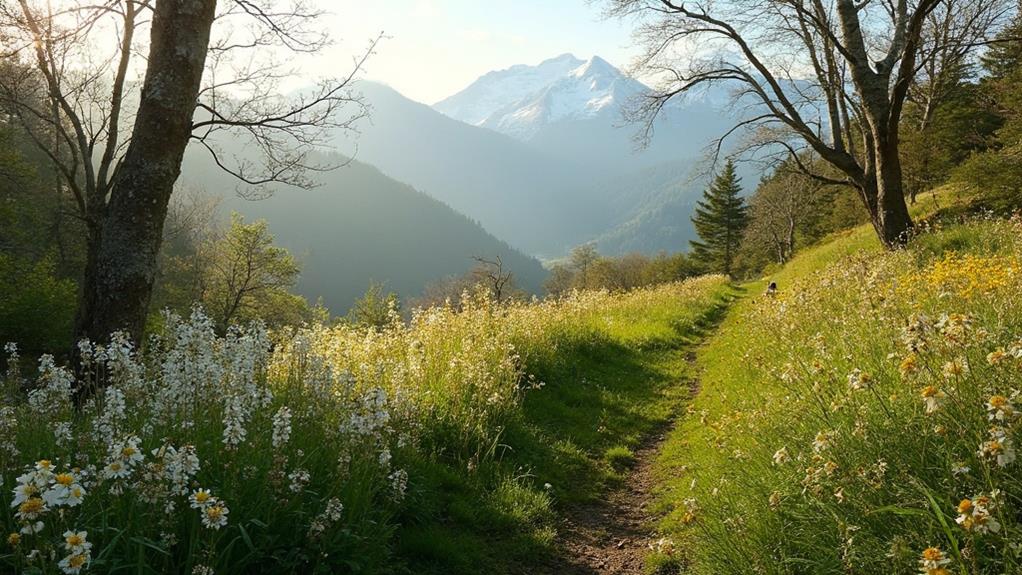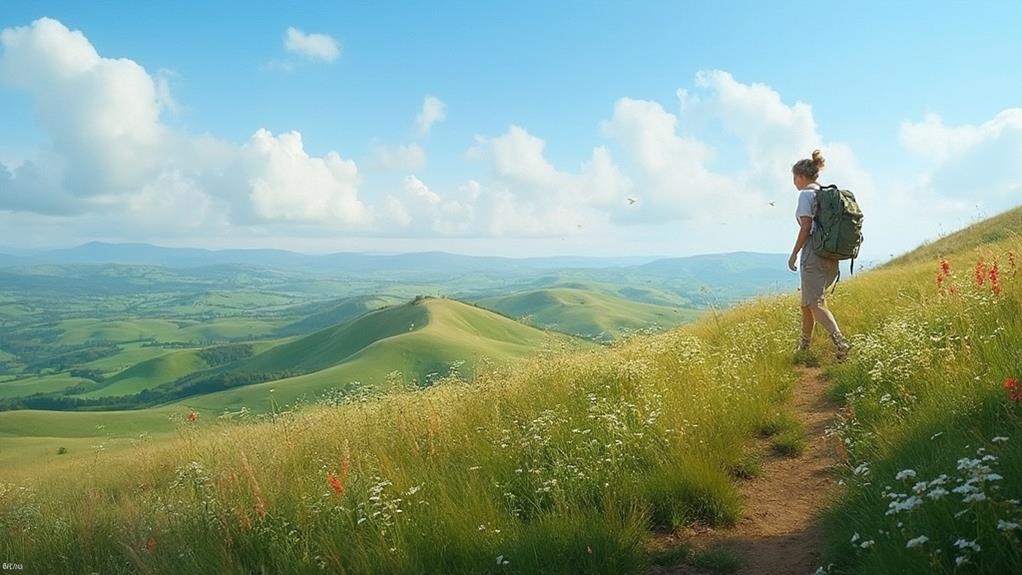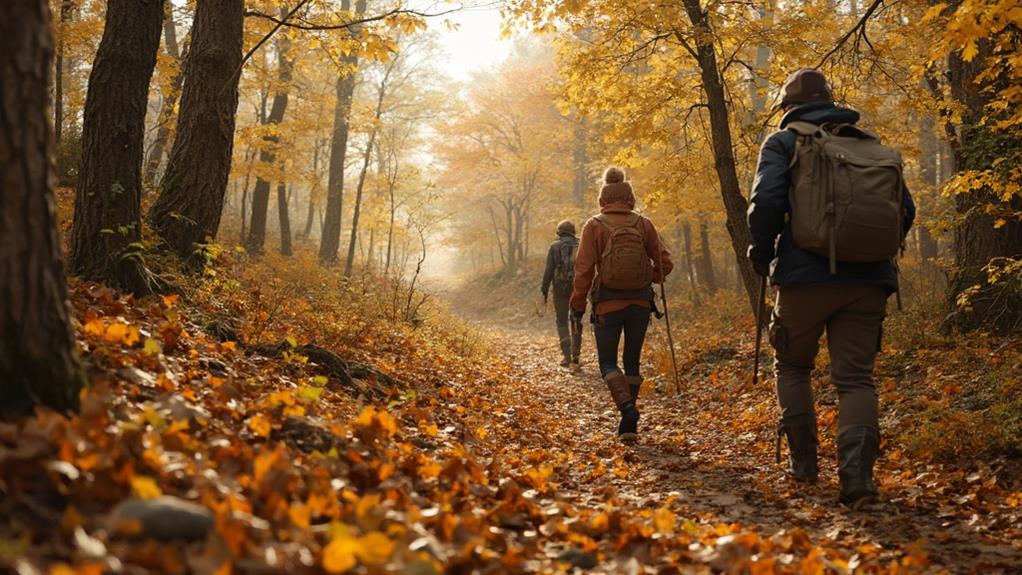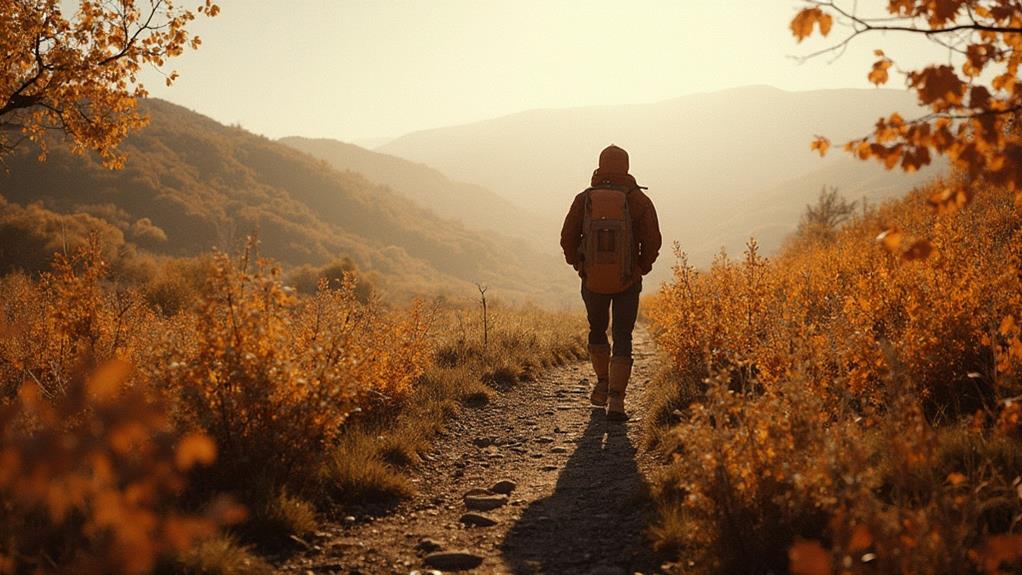For beginners enthusiastic to set out on fell walking, late March to early October provides ideal weather conditions and extended daylight hours for a safe and enriching venture. May and June present the most favorable trail conditions, with their pleasant climates and reduced risks of sudden weather changes. Equipping oneself with the correct gear, such as sturdy waterproof boots and layered clothing, guarantees preparedness against unpredictable UK weather. Early spring and late autumn offer unique experiences, including vibrant flora and increased wildlife activity. Understanding route planning and basic navigation enhances safety; further insights will assist in maximizing this rewarding outdoor pursuit.
Key Takeaways
- Late March to early October is the optimal timeframe for beginners to start fell walking.
- May and June offer pleasant weather and extended daylight, ideal for beginners.
- September to early October combines mild weather with reduced foot traffic for a peaceful experience.
- Mid-week excursions during off-peak times enhance solitude and tranquility on trails.
- Careful weather monitoring and route planning are essential for safe fell walking.
Optimal Seasons for Beginners
Starting on fell walking as a beginner calls for strategic planning to enhance safety and enjoyment, with a key consideration being the choice of season. Late March to early October is ideal for novices, with favorable conditions such as warmer temperatures and drier trails enhancing the experience.
Within this timeframe, May and June stand out as particularly suitable months for summer walking, offering both pleasant weather and extended daylight hours to accommodate longer excursions.
A critical aspect of planning is understanding trail etiquette, which includes respecting other hikers by maintaining a safe distance and yielding the trail when necessary. This becomes especially relevant during peak periods like the Easter holidays and bank holidays, when trails are more congested.
To avoid these crowds and provide a tranquil experience, beginners are advised to schedule their walks during off-peak times.
September to early October also provides excellent conditions, combining mild weather with reduced foot traffic. This period allows for a more serene introduction to fell walking, minimizing the risk of accidents often associated with crowded paths.
Adhering to these guidelines guarantees a safe and enjoyable entry into the world of fell walking.
Navigating Spring Trails

Spring's shift offers an exemplary period for beginners to start on fell walking, presenting a unique blend of accessibility and natural beauty. The season's milder, stable conditions make it ideal for venturing into renowned trails like the Lake District. Route planning is essential, especially for novices. It involves understanding trail markers, which are vital for safe navigation. These markers guide hikers along the path, reducing the risk of veering off course, especially when spring weather can be unpredictable.
Proper route planning encompasses evaluating trail difficulty, estimated duration, and identifying potential hazards. Spring provides numerous dry days, significant for testing and honing these essential navigation skills. The vibrant flora and blooming flowers enhance the hiking experience, inviting a sensory immersion into nature's rebirth.
| Trail Name | Difficulty Level | Expected Duration |
|---|---|---|
| Catbells | Moderate | 2-3 hours |
| Helvellyn | Challenging | 6-7 hours |
| Loughrigg Fell | Easy | 1-2 hours |
| Scafell Pike | Challenging | 8-10 hours |
| Buttermere Lake | Easy | 4-5 hours |
Beginner walkers are encouraged to select less crowded routes, benefiting from a peaceful environment to fully appreciate the natural surroundings. By focusing on methodical route planning and understanding trail markers, novices can confidently navigate spring trails, ensuring a rewarding and safe fell walking experience.
Autumn Fell Walking Benefits
Autumn's tapestry of vibrant foliage creates a picturesque backdrop, enhancing the appeal of fell walking during this season. The stunning scenic landscapes provide a unique opportunity for beginners to immerse themselves in nature's vivid colors.
Cooler temperatures contribute to ideal hiking conditions, reducing the risk of heat-related issues that can occur in warmer months. This technical advantage allows novices to focus on navigation and endurance without the added stress of excessive heat.
The decreased trail traffic in autumn means that beginners can enjoy a more peaceful experience, fostering a deeper connection with the natural environment. This solitude can be particularly beneficial for those new to fell walking, as it allows for a more personalized pace and reflection.
Additionally, autumn is a prime time for wildlife spotting; as animals prepare for winter, their activities become more visible, providing an educational and enriching experience for hikers.
Practical considerations also favor autumn fell walking. The decline in peak season tourism results in easier access to accommodations and local services.
For beginners, this translates into a more relaxed planning process and the ability to focus on honing essential skills for future endeavors in fell walking.
Weather Considerations

While the allure of autumn's beauty is undeniable, understanding the weather's impact on fell walking is essential for beginners. The UK's weather patterns are notoriously fickle, making it important for novice walkers to carefully plan their outings between late March and early October. During this period, the likelihood of encountering warmer, drier conditions increases, greatly enhancing the overall fell walking experience.
Particularly in the peak months of May and June, trail conditions are ideal due to pleasant temperatures and reduced rainfall. This minimizes the risk of slippery paths and muddy terrains, which can be hazardous for those unaccustomed to traversing uneven surfaces.
However, the unpredictable nature of the UK's climate necessitates vigilance. Regularly monitoring weather forecasts is vital for anticipating sudden changes, such as storms, which can transform benign trails into treacherous routes.
In addition to weather forecasts, understanding the impact of recent rainfall on trail conditions is critical. Rain can initially make paths challenging, but subsequent dry periods often result in firmer, more manageable trails, mitigating risks like mudslides.
As a result, strategic planning based on weather patterns not only enhances safety but also guarantees a more enjoyable fell walking experience.
Avoiding Crowds on Trails
Maneuvering the complexities of trail congestion is crucial for a fulfilling fell walking experience. Effective crowd management begins with strategic planning; avoid peak seasons such as Easter and bank holidays when trails are most congested.
Opt for mid-week excursions to coastal paths and popular hiking destinations, where solitude can be maximized. Booking accommodations in advance during off-peak times guarantees access to necessary amenities, enhancing the overall experience.
May and June present ideal conditions for fell walking, offering pleasant weather with reduced tourist activity compared to the summer peak. This period allows for a tranquil exploration of trails, wherein walkers can practice trail etiquette without the pressure of crowded paths.
Selecting local trails or lesser-known routes is advisable for those seeking serenity, as these paths typically see fewer visitors, minimizing disruptions.
Adhering to trail etiquette is critical in congested areas; walkers should maintain a respectful distance, yield appropriately, and minimize noise pollution to create a harmonious environment.
Seasonal Flora and Fauna

With spring ushering in a vivid array of wildflowers, beginners will find this season ideal for commencing fell walking adventures. The emergence of flora such as bluebells and primroses during late March to early May not only transforms the landscape into a canvas of vibrant colors but also offers an excellent opportunity for floral identification.
These species are harbingers of the season's renewal and provide budding naturalists with a firsthand experience of identifying local vegetation. Furthermore, this period is perfect for wildlife observation, as the return of migratory bird species enhances the auditory and visual aspects of the walk.
Birdwatching becomes particularly rewarding during this time, with an increased likelihood of observing nesting activities, which can greatly enrich the hiking experience. Safety precautions should be taken to avoid disturbing wildlife, maintaining a respectful distance to guarantee both personal and animal safety.
In quieter months like early spring and late autumn, beginners can also encounter diverse wildlife, including deer and small mammals. These encounters are often more pronounced due to reduced human activity, offering beginners a serene environment to appreciate the local fauna.
Consequently, spring and autumn provide unique and enriching experiences for those new to fell walking.
Gear Essentials for Beginners

For beginners starting on fell walking, investing in the right gear is essential to guarantee both safety and comfort. Selecting appropriate footwear is critical; quality walking boots or shoes should feature robust ankle support, superior grip, and reliable waterproofing. These footwear features are fundamental to navigate varied terrains and weather conditions while preventing injuries.
Clothing materials also play a significant role in maintaining comfort and safety. Layered clothing is recommended, with an emphasis on multiple thin layers instead of a single thick layer. This approach allows for ideal temperature regulation and adaptability to changing climates.
Waterproof gear, such as jackets and over trousers, is indispensable in the unpredictable UK weather, providing protection against wind and rain. Avoid cotton and denim, as they retain moisture and can become heavy and uncomfortable. Instead, opt for breathable, moisture-wicking fabrics to enhance overall comfort.
A small daypack should accompany you on your treks, equipped with essential items like a first aid kit, snacks, water, and a thermal blanket. These preparations guarantee readiness for any unexpected situations, reinforcing both safety and the enjoyment of the fell walking experience.
Safety and Preparation Tips

When starting on fell walking, it is imperative to equip oneself with essential safety gear, including a first aid kit, a whistle, and a reliable map, ensuring readiness for unforeseen circumstances.
Additionally, emergency preparedness steps such as frequently checking weather updates and informing a trusted contact of your intended route and estimated return time are vital for mitigating potential risks.
Proper attire, encompassing weather-resistant clothing and sturdy walking boots with adequate ankle support, further enhances safety on unpredictable terrains.
Essential Safety Gear
Beginning on a fell walking journey necessitates meticulous preparation, particularly concerning essential safety gear. Proper equipment is essential to guarantee both comfort and security amid the unpredictable terrains and ever-changing weather conditions of the UK. A thorough first aid kit is indispensable for addressing minor injuries promptly and effectively. This kit should include bandages, antiseptic wipes, and blister treatment, which are crucial for immediate response to common walking ailments.
In addition to the first aid kit, several other items are fundamental for safety:
- Weather-resistant clothing: Important for protection against the elements, maintaining warmth, and guaranteeing safety during inclement weather.
- Quality walking boots: Provides necessary ankle support and enhanced grip, essential for traversing varied terrains safely.
- Fully charged mobile phone: Critical for communication in emergencies, guaranteeing you remain connected with support services or loved ones.
Furthermore, carrying an emergency whistle and torch can aid in signaling for help if necessary.
It is also prudent to pack extra food, water, and a thermal blanket, which offer sustenance and warmth if your journey extends unexpectedly.
Informing someone of your route and expected return enhances overall safety, adding an extra layer of protection.
Emergency Preparedness Steps
How can one assure safety while commencing on a fell walking expedition? Preparedness stands as the cornerstone of a secure journey.
Equipping oneself with an emergency kit is crucial. This should encompass essential items such as a whistle, torch, first aid supplies, a thermal blanket, extra food, water, and a mobile phone. Such provisions can prove invaluable during unforeseen circumstances on the trail.
Equally critical is the dissemination of your walking itinerary to a trusted individual who can notify authorities if you fail to return as planned. This safety measure greatly enhances your chances of a timely rescue.
Additionally, possessing fundamental first aid knowledge empowers you to administer immediate care to yourself or fellow walkers, potentially mitigating the severity of injuries.
Staying informed about weather conditions is another essential precaution. Regularly consult forecasts to anticipate sudden storms or temperature fluctuations, thereby averting perilous situations.
Additionally, a map and compass are indispensable tools for effective navigation, especially in challenging terrains. Confirm proficiency in their use to avoid disorientation.
Building Skills Gradually

For beginners starting on the journey of fell walking, embracing a steady progression is vital, beginning with manageable routes and incrementally increasing the complexity of the terrain.
Focusing on core strength through exercises such as planks and squats can greatly enhance stability and reduce the risk of injury on uneven ground.
Additionally, developing wayfinding skills by practicing with a map and compass is essential for ensuring safety and confidence in traversing more remote and challenging trails.
Embrace Steady Progression
Starting a journey of fell walking necessitates a commitment to embracing steady progression, ensuring that skills are cultivated gradually and safely. Skill acquisition is fundamental, beginning with the selection of ideal timing. Late March to early April offers milder, predictable weather, a prime environment for novices.
Pacing strategies should be employed, starting with shorter walks on less challenging terrains. This methodical approach builds endurance and confidence, preventing overexertion and minimizing injury risks.
To further enhance your fell walking proficiency, integrating regular training sessions focused on specific techniques is essential. Navigation skills, sustainable pacing, and terrain assessment are cornerstones of a successful fell walking experience. Utilizing resources such as the BMC's New Hill Walkers booklet can provide indispensable insights into these areas.
Joining local walking clubs or groups is highly recommended for shared learning and support. Here are three benefits of such engagement:
- Shared Knowledge: Gain insights and tips from experienced walkers.
- Camaraderie: Foster motivation and enjoyment through shared experiences.
- Safety: Benefit from collective decision-making during walks.
Embrace this structured approach, ensuring that each step you take is informed, deliberate, and aligned with your progression goals.
Focus on Core Strength
When commencing on the journey of fell walking, prioritizing core strength is essential for maintaining balance and stability in the challenging terrains encountered. Core exercises, such as planks, bridges, and Russian twists, are fundamental to enhancing core endurance, vital for sustaining energy and posture during prolonged hikes. These exercises target the abdominal, oblique, and lower back muscles, fortifying the body against the rigors of uneven surfaces and steep ascents.
Engaging in complementary activities like yoga or pilates can further augment core endurance by improving overall body control and flexibility. This holistic approach guarantees that the core muscles work synergistically with the rest of the body, providing ideal support during both uphill climbs and downhill descents.
Gradual progression in the intensity and duration of core workouts is advised to mitigate the risk of injury and adapt the body to the unique physical demands of fell walking. Consistent core training, when combined with proper technique, greatly reduces fatigue, enhancing performance on multi-day treks.
Develop Navigation Skills
Mastering the art of wayfinding is an essential skill for any fell walker, ensuring safe and efficient traversal of complex landscapes. Initiating this journey requires a strong foundation in map orientation and terrain assessment.
Begin by familiarizing yourself with essential map reading and compass skills, significant for wayfinding varied terrains. A topographical map offers detailed insights into elevation changes and potential landmarks, aiding in precise route planning.
Gradually build your wayfinding skills by starting with familiar local trails. This controlled environment allows you to refine your abilities before tackling more challenging areas.
To enhance your skills, consider the following steps:
- Familiarize with Basic Tools: Understand how to interpret topographical maps and use a compass to navigate through diverse terrains effectively.
- Practice with Technology: While traditional methods are important, integrating smartphone apps or GPS devices can offer supplementary guidance, enhancing your wayfinding accuracy.
- Engage with the Community: Joining local hiking groups or clubs that offer navigation workshops provides opportunities to learn from seasoned trekkers, offering practical experience with guidance.
Frequently Asked Questions
How to Get Fit for Hill Walking for Beginners?
To get fit for hill walking, beginners should adopt fitness routines focusing on uphill endurance and muscle strength. Incorporate essential gear for safety. Engage in resistance training and practice on varied terrains to enhance balance and technique.
How to Start Fell Walking?
To commence fell walking, prioritize gear essentials such as durable boots and weather-resistant clothing. Emphasize safety tips, including mastering navigation skills and choosing manageable routes. Consider joining groups for guidance, fostering both technical proficiency and safety awareness.
Which Is the Best Time for Walking?
The ideal time for walking, considering weather conditions and seasonal changes, is during late spring to early autumn. This period offers stable weather, reducing hazards such as hypothermia and slips, thereby enhancing safety and enjoyment for walkers.
What Is the Best Time for Outdoor Walk?
The ideal period for outdoor walking in the UK is from late March to early October. This timeframe maximizes seasonal advantages and favorable weather conditions, ensuring enhanced enjoyment. Always assess trail safety and prepare for variable terrain.
Conclusion
In summary, selecting the appropriate season for novice fell walkers necessitates careful consideration of weather conditions, trail accessibility, and safety measures. Spring and autumn are ideal, offering manageable weather and reduced trail congestion. Thorough preparation, including suitable gear and awareness of seasonal flora and fauna, enhances safety. Gradual skill development and adherence to safety guidelines are imperative for minimizing risks and maximizing enjoyment. Emphasis on preparation and awareness guarantees a rewarding and secure fell walking experience for beginners.